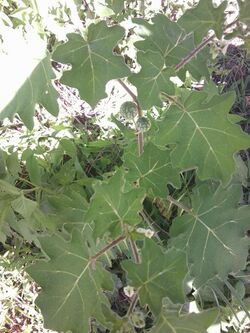Biology:Yellow-fruit nightshade
| Yellow-fruit nightshade | |
|---|---|

| |
| Scientific classification Error creating thumbnail: Unable to save thumbnail to destination
| |
| Kingdom: | Plantae |
| Clade: | Tracheophytes |
| Clade: | Angiosperms |
| Clade: | Eudicots |
| Clade: | Asterids |
| Order: | Solanales |
| Family: | Solanaceae |
| Genus: | Solanum |
| Species: | S. virginianum
|
| Binomial name | |
| Solanum virginianum L.
| |
| Synonyms[1] | |
|
List
| |
Solanum virginianum, also called Surattense nightshade,[2] yellow-fruit nightshade, yellow-berried nightshade, Indian nightshade, Thai green eggplant, or Thai striped eggplant (from the unripe fruit),[3] is a medicinal plant used mostly in India. Some parts of the plant, such as the fruit, are poisonous.[4] The common name is Kantakari. Solanum surattense Burm. f. and Solanum xanthocarpum Schrad. and Wendl. are synonyms of Solanum virginianum L. (Sharma et al., 2010).
Description
Plant body
Thorny Nightshade is an erect herb, that is sometimes woody at the base, and measures 50–70 cm (20–28 in) tall. It is copiously armed with sturdy, needlelike, and broad-based prickles measuring 0.5-2cm x 0.5-1.5mm.[5]
Leaves
The plant has ovate-oblong, sinuated leaves that are unequally paired, with blades measuring 4-9cm × 2-4.5cm. They have an acute apex, unequal lobes and are either pinnate or possessive of usually 5-9 lobes. The veins and stalks of the leaves are prickly, and the stalks have a length of 2-3.5cm.
Inflorescence
The racemose inflorescence of the plant is 4-7cm tall, and the bell-shaped sepal tube has a diameter of 1cm.
Flowers
The blue-purple flowers measure 1.4–1.6 cm × 2.5 cm. The petals are ovate-deltate, measure 6–8mm, and are densely pubescent with stellate hairs. The filaments have a measurement of 1mm, the anthers 8mm, and the style 1cm.
Fruits
The yellow-fruit nightshade’s fruiting pedicels are 2–3.6cm tall. They have prickles and sparse stellate hairs, while the fruiting sepals are prickly and sparsely pubescent. Pale yellow berries of 1.3–2.2cm in diameter are produced, when ripe the yellow fruits are around 3cm in diameter.[6] Flowering normally appears around November to May.[7]
Occurrence
The yellow-fruit nightshade is cultivated in the Himalayas, South-East Malaysia, Australia, and the Polynesian region.[8] It is commonly found in open spaces, along roadsides, and elsewhere in India.
Medicine
In-vitro antioxidant and in-vivo antimutagenic properties of Solanum xanthocarpum seed extracts have been examined by qualitative phytochemical screening, which reveals the presence of polyphenols, flavonoids, glycoside, alkaloids, carbohydrates, and reducing sugar in the plant. Based on preliminary qualitative phytochemical screening, quantitative estimation of polyphenols in the plant has also been performed. The quantitative estimation of alcoholic extracts found significant amounts of polyphenols, as compared to aqueous extracts. In-vitro antioxidant studies have been performed by two methods: DDPH, and a superoxide radical scavenging method. The alcoholic extracts showed significant antioxidant properties, as compared to aqueous extracts. Based on polyphenols and antioxidant properties, alcoholic extracts were used for the antimutagenic (clastogenic) test. The alcoholic extracts produced significant results regarding the antimutagenic activity.[9]
Gallery
See also
- Asian eggplants:
- Thai eggplant, common cultivar types in Thailand are 'Thai Purple', 'Thai Green', 'Thai Yellow', and 'Thai White' (cultivars of Solanum melongena).
- Lao eggplant for common cultivar types in Laos such as 'Lao Green Stripe', 'Lao Purple Stripe', 'Lao Lavender', and 'Lao White' (cultivars of Solanum melongena).
- African eggplant, gboma, or gboma eggplant (Solanum macrocarpon): Cà pháo is used too in Vietnamese cuisine (Vietnamese eggplant?)
Note
References
- ↑ "Solanum virginianum L.". Board of Trustees of the Royal Botanic Gardens, Kew. 2017. http://powo.science.kew.org/taxon/urn:lsid:ipni.org:names:821496-1#synonyms.
- ↑ "Solanum virginianum". Natural Resources Conservation Service PLANTS Database. USDA. https://plants.usda.gov/core/profile?symbol=SOVI9.
- ↑ René T. J. Cappers, Reinder Neef, Renée M. Bekker, Digital Atlas of Economic Plants: Acanthaceae - Hypoxidaceae, Vol. 2A, Barkhuis, 2009, p. 269
- ↑ Michel H. Porcher, Know your eggplants - Part 4:The related Nightshades
- ↑ Gokhale, Mahesh &, S.S.Shaikh & Chavan, Niranjana &, S.V.Toro. (2013). Floral wealth of Achara- A sacred village on central west coast of India.
- ↑ Rémi Tournebize, Points on the ethno-ecological knowledge and practices among four Scheduled Tribes of the Nilgiris: Toda, Kota, Alu Kurumba and Irula, with emphasis on Toda ethnobotany, Institute of Research for Development (Marseille), Thesis 2013, p. 103
- ↑ "Flowers of India: Thorny Nightshade". http://www.flowersofindia.net/catalog/slides/Thorny%20Nightshade.html.
- ↑ "Solanum surattense Burm. f.". http://folkmedsindh.com.pk/solanum-surattense-burm-f/.
- ↑ Antioxidant and Antimutagenic (Anticlastogenic) Effect of Solanum xanthocarpum seed extracts. Santosh Kumar Vaidya, Dharmesh K. Golwala and Darpini S. Patel. International Journal of Pharmaceutical Sciences and Nanotechnology (ISSN: 0974-3278) 2020: Volume 13, Issue 4, page 5005-5010.[1]
External links
- {{citation
| mode = cs1 | title = Solanum virginianum L. | work = Germplasm Resources Information Network (GRIN) | url = https://npgsweb.ars-grin.gov/gringlobal/taxonomydetail.aspx?401897 | publisher = [[Organization:Agricultural Research ServAgricultural Research Service (ARS), United States Department of Agriculture (USDA) | access-date = }}
- "Solanum virginianum L.". National Center for Biotechnology Information (NCBI). https://www.ncbi.nlm.nih.gov/Taxonomy/Browser/wwwtax.cgi?id=223891.
Wikidata ☰ Q1483086 entry
 |






